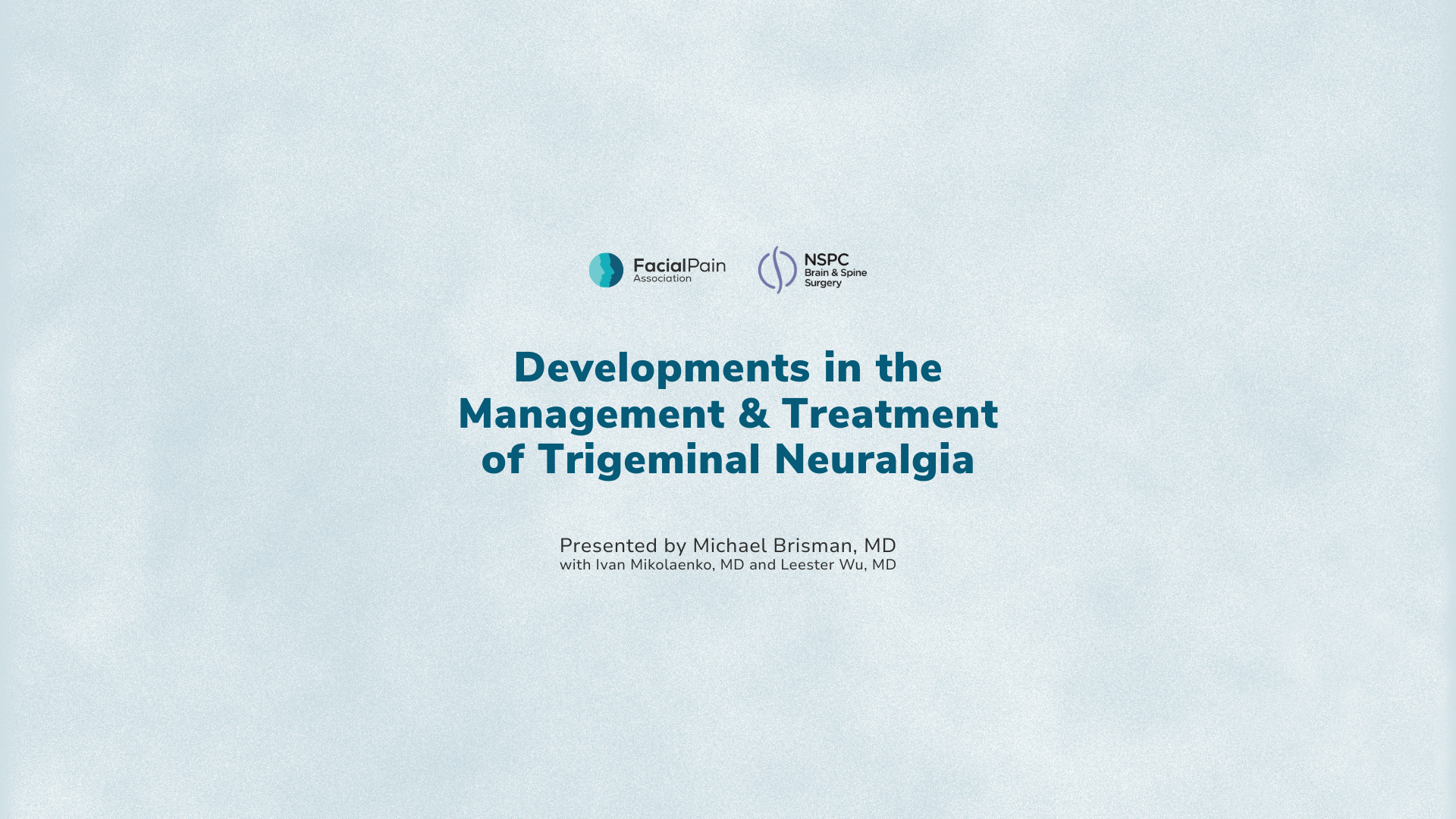It is estimated that 150,000 people each year are diagnosed with trigeminal neuralgia (TN) (Pilitsis, 2024). If you are one of those suffering from TN, also known as tic douloureux, you know firsthand the impact this chronic pain condition can have on your quality of life. The sudden, intense discomfort caused by irritation of the trigeminal nerve can be both physically and emotionally devastating. You may feel yourself avoiding activities others take for granted, like simply brushing your teeth, applying make-up, or even enjoying the breeze against your face.
If you have been diagnosed with TN and your prescribed medication either does not control the symptoms, has become less effective, or produces intolerable side effects, there is hope. Specialized surgery, minimally invasive procedures and noninvasive treatments have proven highly effective in reducing pain and improving quality of life for people suffering from trigeminal neuralgia.
Microvascular Decompression (MVD)
Microvascular decompression is an in-patient surgical procedure designed to alleviate pressure on the trigeminal nerve caused by blood vessels that are either wrapping around the nerve or touching it.
While the patient is asleep under general anesthesia, an incision is made behind the ear and through it, a microscopic cushion is placed between the nerve and the blood vessels compressing it. Studies have shown MVD can provide significant long-term relief, with success rates of 70-80%. In fact, research published in the Journal of Neurosurgery found 80% of patients experienced substantial pain relief, with 60% remaining pain-free after five years (Barker et al., 1996).
In order to further improve the success and recovery from surgery, surgeons may utilize multiple modalities. For instance, neuronavigation — a computer-assisted imaging technology that provides a three-dimensional view inside the surgical area — allows the surgeon to use a smaller, more accurately placed incision. In addition, the use of an endoscope, which is a tiny camera inserted into the surgical site, further enables surgeons to see around the nerve to decompress it 360° and detect any other potential blood vessel compression that may be hidden.
Most patients undergoing microvascular decompression will be in the hospital for one to two days after surgery and recovery time can last about two to four weeks.
Balloon Compression
Balloon compression, also known as percutaneous balloon compression (PBC), is a minimally invasive surgical procedure requiring the patient to be asleep under general anesthesia. Guided by X-ray imaging, the surgeon inserts a needle through the cheek and up into the base of the skull at the trigeminal ganglion, the point at which the nerve fans out into the ophthalmic, maxillary, or mandibular nerve branches. Through this hollow needle a catheter is inserted and then inflated like a balloon with a liquid solution, which compresses the nerve and disrupts pain signals to the brain. Shortly after, the catheter is deflated and removed, along with the needle. This method of compressing of the trigeminal fibers can provide immediate pain relief for most people undergoing the procedure (Valenzuela et al., 2023).
One study reported this outpatient procedure has been shown to have an 80% success rate, with many patients experiencing pain relief for 2-3 years (Kanpolat et al., 2001). It is a swift, low-risk technique that can significantly improve quality of life and be safely repeated if pain returns.
While some patients may be admitted for an overnight hospital stay, many are able to go home the same day of the procedure. Most patients can return to normal activities within a few weeks.
Gamma Knife® Radiosurgery
Gamma Knife® radiosurgery is a non-invasive procedure using focused radiation to target and damage the trigeminal nerve root, effectively blocking pain signals that would otherwise travel to the brain. This method is ideal for patients seeking a nonsurgical option with lower risks. It does not require any surgical incisions to be made in the skin and patients are usually awake during the procedure.
Some Gamma Knife® radiosurgeries use a frame on the patient’s head to keep it immobilized during the procedure. In this case, a local anesthetic is used on the forehead and back of the head to eliminate discomfort where the pins of the frame will make contact with patient’s skin. Using computed tomography (CT) and/or magnetic resonance imaging (MRI) the medical team will determine the size and location of the area receiving radiation. As the patient lays on a table, the Gamma Knife® precisely beams radiation to the trigeminal nerve root. This part of the procedure can last from about 15 minutes to over an hour, depending on the area of treatment.

Gamma Knife®: Elekta Esprit™
According to The Lancet Neurology, Gamma Knife® radiosurgery offers significant pain relief in 70-80% of patients, with a gradual improvement over several weeks or months (Régis et al., 2016). This precise technique allows for effective treatment with minimal recovery time. Most patients can return home the same day as the procedure and typically return to normal activities within one to two days.
When to Consider Surgery for Trigeminal Neuralgia
Surgery may be recommended when medications are not effective in controlling the pain or the side effects are too disruptive to everyday life. The choice of procedure will depend on a few factors, including:
- The cause, location and severity of pain
- The patient’s physical health and medical/surgical history
- If the patient has been diagnosed with multiple sclerosis
- Which part of trigeminal nerve is most affected (i.e., the ophthalmic, maxillary, or mandibular nerve branch)
If your facial pain is getting in the way of leading a normal life, there is hope. Schedule an appointment today with your healthcare provider to discuss treatment options or seek out advice with an experienced neurological care provider. It’s the most important step in finding relief from your trigeminal neuralgia.
References
- Barker FG, Jannetta PJ, Bissonette DJ, et al. The long-term outcome of microvascular decompression for trigeminal neuralgia. J Neurosurg. 1996;84(5):818-825. doi:10.3171/jns.1996.84.5.0818.
- Jho HD, Lunsford LD. Microvascular decompression for trigeminal neuralgia. Acta Neurochir (Wien). 1997;139(5):421-425. doi:10.1007/BF01414117.
- Kanpolat Y, Savas A, Bekar A, Berk C. Percutaneous controlled radiofrequency trigeminal rhizotomy for the treatment of idiopathic trigeminal neuralgia: results and considerations in 1000 patients. Neurosurgery. 2001;48(3):524-532; discussion 532-534. doi:10.1097/00006123-200103000-00008.
- Taha JM, Tew JM Jr. Comparison of surgical treatments for trigeminal neuralgia: reevaluation of radiofrequency rhizotomy. Neurosurgery. 1996;38(5):865-871. doi:10.1097/00006123- 199605000-00016.
- Régis J, Tuleasca C, Resseguier N, et al. Long-term safety and efficacy of Gamma Knife® surgery in classical trigeminal neuralgia: a 497-patient historical cohort study. Lancet Neurol. 2016;15(11):1044-1052. doi:10.1016/S1474-4422(16)30179-1.
- Pilitsis, J. (April 10, 2024). Trigeminal Neuralgia. American Association of Neurological Surgeons. Accessed 8/19/24 from https://www.aans.org/patients/conditions-treatments/trigeminalneuralgia/
- Valenzuela Cecchi B, Figueroa F, Contreras L, et al. (August 17, 2023) Percutaneous Balloon Compression for the Treatment of Trigeminal Neuralgia: A Review of 10 Years of Clinical Experience. Cureus. 15(8): e43645. doi:10.7759/cureus.43645





































